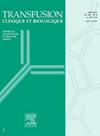ICU的限制性红细胞输血:临床依从性的趋势。
IF 1.2
4区 医学
Q4 HEMATOLOGY
引用次数: 0
摘要
在危重患者中输血的风险和益处之间的平衡一直是争论的焦点。临床指南建议对大多数危重患者采用限制性输血策略,输血血红蛋白触发值为7 g/dL。然而,最近的文献显示,许多输注红细胞时血红蛋白高于7 g/dL。我们的目的是评估我们自己的输血方案的依从性,以及整个重症监护病房(ICU)和亚组输血政策的变化。方法:回顾性观察队列研究2017 - 2024年在阿姆斯特丹UMC ICU住院的患者。数据提取自电子健康记录和荷兰国家质量登记处(NICE)。参照专科进行亚组分析。结果:共分析了24761例ICU住院患者,3444例ICU住院患者中有12064例红细胞输注。输血前血红蛋白中位数从2017年的7.7 g/dL(第1 -3四分位数7.1 - 8.4)降至2024年的6.8 g/dL(第1 -3四分位数6.4 - 7.3)。结论:我们报告了在三级护理ICU中独立于患者转诊专业的全面限制性红细胞输血方案的长期成功实施。2024年输血前平均血红蛋白水平为6.8 g/dL。本文章由计算机程序翻译,如有差异,请以英文原文为准。
Restrictive RBC transfusion in the ICU: Trends in clinical adherence
Introduction:
The balance between the risks and benefits of red blood cell (RBC) transfusions in critically ill patients is of ongoing debate. Clinical guidelines suggest a restrictive transfusion strategy with a transfusion hemoglobin trigger of 7 g/dL for most critically ill patients. However, recent literature shows many RBC transfusions are given with a prior hemoglobin above 7 g/dL. We aimed to evaluate adherence to our own transfusion protocol and changes in transfusion policy over time for the entire Intensive Care Unit (ICU) and in subgroups.
Methods:
Retrospective observational cohort study of patients admitted between 2017 and 2024 to the ICU of Amsterdam UMC. Data was extracted from the electronic health record and the Dutch national quality registry (NICE). Subgroup analysis was done based on referring specialty.
Results:
In total 24 761 ICU stays were analyzed with 12 064 RBC transfusions in 3444 ICU stays. Median hemoglobin value before RBC transfusion decreased from 7.7 g/dL (1st–3rd quartile 7.1–8.4) in 2017 to 6.8 g/dL ((1st–3rd quartile 6.4–7.3) in 2024 (p 0.001). This decrease was present in all subgroups. The percentage of RBC transfusions with a prior hemoglobin 7 g/dL increased from 18.8% to 64.8% (p 0.001).
Conclusion:
We report the long term successful implementation of a comprehensive restrictive RBC transfusion protocol in a tertiary care ICU, independent of the patient’s referring specialty. A median hemoglobin level of 6.8 g/dL before RBC transfusion was reached in 2024.
求助全文
通过发布文献求助,成功后即可免费获取论文全文。
去求助
来源期刊
CiteScore
2.50
自引率
11.80%
发文量
234
审稿时长
36 days
期刊介绍:
Transfusion Clinique et Biologique, the official journal of the French Society of Blood Transfusion (SFTS):
- an aid to training, at a European level
- the only French journal indexed in the hematology and immunology sections of Current Contents
Transfusion Clinique et Biologique spans fundamental research and everyday practice, with articles coming from both sides. Articles, reviews, case reports, letters to the editor and editorials are published in 4 editions a year, in French or in English, covering all scientific and medical aspects of transfusion: immunology, hematology, infectious diseases, genetics, molecular biology, etc. And finally, a convivial cross-disciplinary section on training and information offers practical updates.
Readership:
"Transfusers" are many and various: anesthetists, biologists, hematologists, and blood-bank, ICU and mobile emergency specialists...

 求助内容:
求助内容: 应助结果提醒方式:
应助结果提醒方式:


